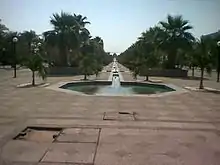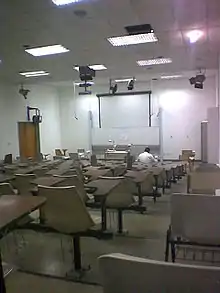جامعة الملك عبد العزيز | |
.jpg.webp) | |
Other name | KAU |
|---|---|
| Motto | اقْرَأْ بِاسْمِ رَبِّكَ "Read: in the Name of your Lord" (Quran 96:1) |
| Type | Public research university |
| Established | 1967 |
| Endowment | US$1 billion |
| President | Abdulrahman Obaid Al-Youbi |
Administrative staff | 4,000 |
| Students | 117,096 [55,576 Male and 61,520 Female students- Academic session 2022-2023] [1] |
| Location | , , Saudi Arabia 21°29′38″N 39°15′1″E / 21.49389°N 39.25028°E |
| Campus | Both urban and rural |
| Website | www |

King Abdulaziz University (KAU) (Arabic: جامعة الملك عبد العزيز) is a public research university in Jeddah, Saudi Arabia. Established in 1967 as a private university by a group of businessmen led by Muhammad Bakhashab and including author Hamza Bogary, it was named after the country's first monarch, King Abdulalziz ibn Saud.[2] It was converted into a public university by King Faisal in 1974 and is ranked among the most prestigious academic institutions in Saudi Arabia.
With over 117,096 students in 2022, it is the largest university in the country. Located in south Jeddah, the university is the center of teaching and research of the city, comprising 24 faculties, 15 of these are located on the campus and 9 are off-campus. The university also offers some courses that are unavailable at any other universities in Saudi Arabia, such as marine science, meteorology, and astronomy.
History
Private university
In the year 1964, the idea of establishing a private university in the city of Jeddah was originally put forward by Mohammed Ali Hafiz. In the same year, a preparatory committee of 6 members was formed, including Mohamed Ali Hafiz and Muhammad Abu Bakr Bakhashab. Shortly after, then-Crown Prince Faisal officially approved the idea. In 1965, the university's executive committee was formed. In 1966, the KAU held a competition to design their logo. The winning design was submitted by Abdul-Halim Radwi, a local artist from Jeddah.[3]
In the year 1967, King Abdulaziz University was officially established as a private university, with goals to spread higher education in the western region of Saudi Arabia. Prior to this date, there were no higher-education institutions in Jeddah. These goals were met through efforts of high-ranking businessmen and notable Saudi figures; and additionally with the help of King Faisal's encouragement and financial support. The university started its first academic year in 1968, with a relatively small number of students (68 male - 30 female). In 1969, the first faculty was established (Faculty of Economics and Administration). In 1970, the Faculty of Arts and Humanities was established. The university was named after King Abdulaziz, founder of Saudi Arabia.
Public university (1974-present)
In 1974, the Council of Ministers of Saudi Arabia decided to merge the university with the government; converting it to a public university. As of 2017, it had almost 31,000 students, of which 28% are international.[4]
The building's construction was designed by Bangladeshi-American architect Fazlur Rahman Khan.[5]
In 2018, it was ranked the 1st Arab university by Times Higher Education due to very strong citation impact and highly international outlook.[6] It also ranked no. 1 in percentage of total publications with international collaboration, according to US News rankings.[7]
Research programs
Between 2004 and 2014, King Abdulaziz University enacted a program to attract the international community and has welcomed nearly 150 researches or various disciplines. The university has developed international research partners, including in Morocco where it has developed a joint lunar research program with the Astronomic Observatory of Oukaïmeden.[8] The university has 13 different research centers, predominantly in the fields of medicine (medical genomes and osteoperosis), environment and energy, climate change, and desalination.[9]
Founded in the 1970s by Sami Angawi, the research center on pilgrimage to Mecca (Hajj Research Center) conducts a series of works around the religious event, notably on the aspects of logistics surrounding the pilgrimage.[10]
Faculties

.jpg.webp)

Faculty of Engineering
- Electrical Engineering
- Computer Engineering
- Biomedical & Electrical Engineering
- Nuclear Engineering
- Aeronautical Engineering
- Chemical & Materials Engineering
- Civil Engineering
- Electrical & Computer Engineering
- Industrial Engineering
- Mining Engineering
- Production Engineering and Mechanical Systems Design
- Thermal Engineering and Desalination Technology
These programs are accredited by ABET as Substantially Equivalent Programs since 2003.[11]
Faculty of Economics and Administration
The Faculty of Economics and Administration was the first college to be established in King Abdulaziz University, and until this day it is called "The Base of Founder's University," referring to the founder of the country.
- Department of Business Administration
- Department of Finance
- Department of Marketing
- Department of Human Resource Management
- Department of Accounting
- Department of Management Information Systems
- Department of Political Science
- Department of Health Administration
- Department of Public Administration
- Department of Economics
- Department of Law (defunct in 2012; separated into a new faculty)
In 2015, FEA received its fourth international accreditation, the AACSB making it one of the top business colleges in the middle east and across the world.
Faculty of Law
The Faculty of Law was established in 2012 as it segregated from Faculty of Economics and Administration.
- Public Law
- Private Law
Other faculties
- Faculty of Applied Medical Sciences
- Faculty of Medicine
- Faculty of Medicine at Rabigh
- Faculty of Arts and Humanities
- Faculty of Business
- Faculty of Education
- Faculty of Communication and Media
- Faculty of Computing and Information Technology
- Faculty of Design
- Faculty of Meteorology, Environment and Arid Land Agriculture
- Faculty of Nursing
- Faculty of Sciences
- Faculty of Pharmacy
- Faculty of Dentistry
- Faculty of Earth Sciences
- Faculty of Health Sciences
- Faculty of Environmental Designs
- Faculty of Home Economics
- Faculty of Marine Sciences
- Faculty of Tourism
- Faculty of Maritime Studies
- Faculty of Architecture and Planning
Ranking
| University rankings | |
|---|---|
| Global – Overall | |
| ARWU World[12] | 101-150 (2020) |
| CWTS World[13] | 232 (2020) |
| QS World[14] | 106 (2023) |
| THE World[15] | 101 (2023) |
| USNWR Global[16] | 65 (2022-2023) |
| Regional – Overall | |
| QS Arab region[17] | 1 (2020) |
| USNWR Arab countries[18] | 1 (2020) |
King Abdulaziz University is ranked between 101 and 150 since 2020 by Academic Ranking of World Universities.[19] Furthermore, according to U.S. News & World Report Best Global University Ranking, King Abdulaziz University is ranked 44 in 2022.[20] And according to QS World University Rankings, King Abdulaziz University is ranked at number 143 in 2021[21] in the world's top universities ranking by the London-based Quacquarelli Symonds (QS).[22]
KAU has faced criticism for allegedly paying highly cited researchers from around the world to cite KAU as a "secondary academic affiliation" in order to boost their rankings.[23][24][25] It also faced criticism for its high ranking by Times of Higher Education.[26]
Notable alumni
- Magda Abu Ras, microbiologist and Deputy Director of the Saudi Environmental Society
- Nahed Taher, Saudi founder and chief executive officer of Gulf One Investment Bank, which has its headquarters in Bahrain. In 2006, Forbes magazine ranked Taher 72nd in the list of the 100 Most Powerful Women in the World.
- Osama bin Laden, founder and former leader of al Qaeda.
- Sulaiman Abdul Aziz Al Rajhi, Saudi billionaire economist, owner of Al Rajhi Bank, the 38th richest person in the world.
- Adel Fakeih, Saudi billionaire engineer and former mayor of Jeddah.
- Muna AbuSulayman, Saudi businesswoman.
- Waleed Abulkhair, Saudi Arabian lawyer and human rights activist.
- Tariq Alhomayed, journalist and former Editor-in-Chief of the Arabic-language newspaper Asharq Alawsat, the youngest person to be appointed that position.
- Samar Alsaggaf, first female Saudi anatomist
- Tasneem Alsultan, Saudi-American photographer and artist, covering stories primarily for The New York Times and National Geographic
- Yahya Al-Hamud, Saudi politician and Governor of Bareq
- Heba Elsewedy, Egyptian humanitarian
- Saida Hagi-Dirie Herzi, Somali feminist writer
- Mahfouz Marei Mubarak bin Mahfouz, Saudi businessman and philanthropist
- Saleh bin Nasser Al-Jasser, Saudi Minister of transport
- Manal al-Sharif, Saudi women's rights activist.
- Abdallah Bin Bayyah, Muslim scholar, teaches in the university; Bin Bayyah holds a Mauritanian citizenship
- Amr Dabbagh, Saudi economist and businessman. Member of World Economic Forum and founder of Jeddah Economic Forum
- Shalimar Sharbatly, Saudi abstract artist
- Said Aqil Siradj, leader of Nahdlatul Ulama, world's largest Islamic organization in Indonesia
See also
References
- ↑ "King AbdulAziz University". moe.gov.sa. 2019-06-24. Retrieved 2020-08-03.
- ↑ King Abdulaziz University list of founders.
- ↑ "King Abdulaziz University signs 3-year partnership with The Undergraduate Awards". Undergraduateawards.com. 13 March 2015. Archived from the original on 14 August 2018. Retrieved 13 August 2018.
- ↑ "King Abdulaziz University". Timeshighereducation.com. Retrieved 13 August 2018.
- ↑ Kilpatrick, Ryan. "Google Doodle Honors Bangladeshi-American Engineer Fazlur Rahman Khan". TIME. Retrieved 3 April 2017.
- ↑ Aarti Nagraj (21 March 2018). "Revealed: Top 10 universities in the Arab region". Gulfbusiness.com. Retrieved 13 August 2018.
- ↑ "King Abdulaziz University". Usnews.com. Retrieved 13 August 2018.
- ↑ "Entretien avec le directeur de l'Observatoire astronomique de l'Oukaïmeden". Lematin.ma (in French). 26 February 2017. Retrieved 13 August 2018.
- ↑ "Research staff". Kau.edu.sa. Retrieved 13 August 2018.
- ↑ "Stampede near Mecca kills at least 717 pilgrims". Chicagotribune.com. 24 September 2015. Retrieved 13 August 2018.
- ↑ "ABET". Archived from the original on 2007-10-24. Retrieved 2007-12-31.
- ↑ "Academic Ranking of World Universities 2020". Archived from the original on 2020-08-15. Retrieved 2020-10-20.
- ↑ Studies (CWTS), Centre for Science and Technology. "CWTS Leiden Ranking". CWTS Leiden Ranking.
- ↑ "QS World University Rankings 2021". Top Universities.
- ↑ "World University Rankings". Times Higher Education (THE). August 25, 2020.
- ↑ https://www.usnews.com/education/best-global-universities/search
- ↑ "QS University Rankings: Arab Region 2018". Top Universities.
- ↑ U.S. News Education: Best Arab Region Universities Rankings 2020
- ↑ King Abdulaziz University Archived 2017-07-05 at the Wayback Machine - website Academic Ranking of World Universities
- ↑ U.S. News Education: Best Global Universities 2020
- ↑ "King Abdulaziz University (KAU)". Top Universities. 2015-07-16. Retrieved 2019-06-20.
- ↑ "King Abdulaziz University". Times Higher Education (THE). 2018-02-05. Retrieved 2019-01-29.
- ↑ "Citations for sale". The Daily Californian. 2014-12-05. Retrieved 2019-09-01.
- ↑ "Manipulating Citation Rankings". Inside Higher Ed. 2014-07-17. Retrieved 2019-09-01.
- ↑ Alhuthali, Sakhr; Sayed, Anwar A. (2022). "Saudi Universities Rapid Escalation in Academic Ranking Systems: Implications and Challenges". Journal of Controversial Ideas. 2: 1. doi:10.35995/jci02010008. hdl:10044/1/97083. S2CID 248455850. Retrieved 2022-09-01.
- ↑ Gornall, Jonathan (15 March 2020). "University rankings are mostly meaningless". Asia Times.
External links
 Media related to King Abdulaziz University at Wikimedia Commons
Media related to King Abdulaziz University at Wikimedia Commons- Official website
- KAU ranking from Times Higher Education World University Rankings.
- Faculty of Design and Arts